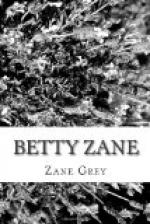Colonel Zane’s house, a two story structure built of rough hewn logs, was the most comfortable one in the settlement, and occupied a prominent site on the hillside about one hundred yards from the fort. It was constructed of heavy timber and presented rather a forbidding appearance with its square corners, its ominous looking portholes, and strongly barred doors and windows. There were three rooms on the ground floor, a kitchen, a magazine room for military supplies, and a large room for general use. The several sleeping rooms were on the second floor, which was reached by a steep stairway.
The interior of a pioneer’s rude dwelling did not reveal, as a rule, more than bare walls, a bed or two, a table and a few chairs—in fact, no more than the necessities of life. But Colonel Zane’s house proved an exception to this. Most interesting was the large room. The chinks between the logs had been plastered up with clay and then the walls covered with white birch bark; trophies of the chase, Indian bows and arrows, pipes and tomahawks hung upon them; the wide spreading antlers of a noble buck adorned the space above the mantel piece; buffalo robes covered the couches; bearskin rugs lay scattered about on the hardwood floor. The wall on the western side had been built over a huge stone, into which had been cut an open fireplace.
This blackened recess, which had seen two houses burned over it, when full of blazing logs had cheered many noted men with its warmth. Lord Dunmore, General Clark, Simon Kenton, and Daniel Boone had sat beside that fire. There Cornplanter, the Seneca chief, had made his famous deal with Colonel Zane, trading the island in the river opposite the settlement for a barrel of whiskey. Logan, the Mingo chief and friend of the whites, had smoked many pipes of peace there with Colonel Zane. At a later period, when King Louis Phillippe, who had been exiled from France by Napoleon, had come to America, during the course of his melancholy wanderings he had stopped at Fort Henry a few days. His stay there was marked by a fierce blizzard and the royal guest passed most of his time at Colonel Zane’s fireside. Musing by those roaring logs perhaps he saw the radiant star of the Man of Destiny rise to its magnificent zenith.
One cold, raw night in early spring the Colonel had just returned from one of his hunting trips and the tramping of horses mingled with the rough voices of the negro slaves sounded without. When Colonel Zane entered the house he was greeted affectionately by his wife and sister. The latter, at the death of her aunt in Philadelphia, had come west to live with her brother, and had been there since late in the preceding autumn. It was a welcome sight for the eyes of a tired and weary hunter. The tender kiss of his comely wife, the cries of the delighted children, and the crackling of the fire warmed his heart and made him feel how good it was to be home again after a three days’ march in the woods.




